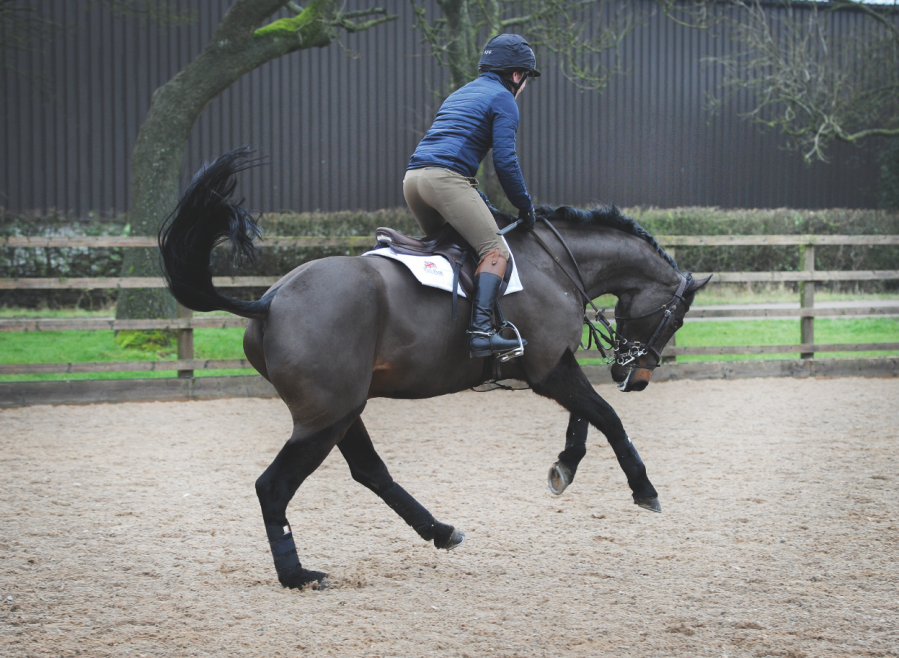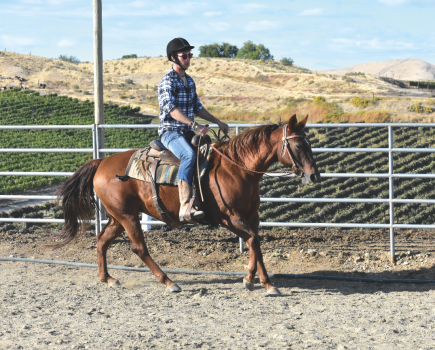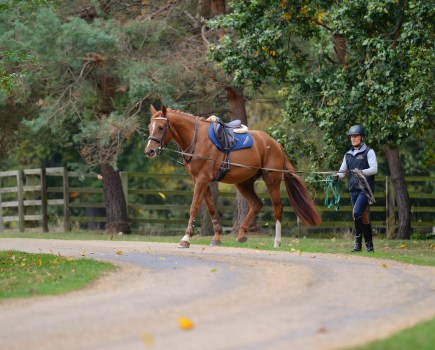Sometimes a horse feels so excitable or tense that trying to contain all that energy beneath you triggers an attack of nerves or sense of unease. I’m talking about the kind of ‘fresh’ horse where you’re reluctant to put your leg on as you fear their reaction. It feels as though all that tension and excitability could spill out at any second. And it might not be at a competition — perhaps you’re preparing for a lesson on a cold, windy day or you’re back on board after a break.
Will you be able to sit the bucks, leaps and spooks? Will the horse ever settle, listen and knuckle down to work? It’s an unnerving situation, but one in which many riders find themselves: trying to warm up a horse who feels too fresh to walk but too sharp to apply any leg contact. It’s a vicious circle — and it happens to the top riders too. Yes, really.
‘You can’t put any pressure on tension’
When superstar event rider Oliver Townend rides into the main arena at Your Horse Live for a joint demo with legendary showjumper Geoff Billington, he’s sitting on Cartoon for the very first time. The six-year-old stallion, who showjumps with Geoff’s wife Sarah, is clearly tense as he spooks his way around the arena. The audience is totally silent, so obvious is it that this horse is on the brink of boiling over.
“All I’m working on to start with is trying to get him relaxed. Wherever I go and whatever I do, I keep riding the trot rhythm and sitting in the middle of the saddle,” says Oliver. “It’s basic things; you can’t put any pressure on tension, so all I’m doing is trotting around, letting him have a really good look at the arena.”
We can hear Oliver quietly talking to and reassuring the tense horse as they work. Using his voice gives the horse something to focus on and listen to, rather than the sights and sounds of his new surroundings, and gives him confidence.
‘You can’t rush a fresh horse’
Nine minutes into the session, Oliver picks up canter.
“I’ve come a little bit lighter in the seat now. When you’ve got a horse that’s fresh or possibly not been worked for a day or two, when you go into canter just lighten the seat to start with,” he advises.
“All I’m trying to do is get the horse breathing; get him to the point where he thinks this is turning into a bit of work. Keep it nice and relaxed. You can’t rush a fresh horse; you need to ride them like you have all day long, even if you haven’t.”
Oliver rides a transition back to trot. Even when varying the pace up and down, maintaining a regular rhythm is important — and if your horse isn’t there yet, keep working towards it.
“As I land in the trot I’m straight back into a nice steady rhythm,” he explains. “He’s quietly starting to relax in the trot and his mind is coming back to me. “If a tense horse like this trips or makes a mistake, you don’t get anywhere by trying to correct that. Just keep riding the same good basic things: rhythm and balance. I stay in rising trot for as long as possible too.”
‘Keep quietly riding a tense horse’
Oliver steers the stallion over some trot poles. Cartoon is still clearly on edge, but he is beginning to look more rideable and as though he is listening to his rider. They do lots of transitions as they navigate the arena to help consolidate the horse’s focus and channel his energy.
“I’m going to do a few walk-to-canters, walk-to-trot — lots of transitions. Again it’s all little exercises getting the horse to give me his brain,” says Oliver. “I want to get to the point where I’m going around waiting for him to think, ‘What is he going to do next?’, rather than him wondering what he’s going to spook at next.”
Oliver can feel that Cartoon is beginning to relax beneath him: it is evident to those watching too.
“When I opened my fingers he straight away wanted to stretch his neck and back, and that’s a really good sign,” says Oliver. “I’m just going to keep quietly riding all the same things into him all the time.”
Suspension from your elbows
Cartoon is inconsistent in the contact, due to tension, but Oliver states that now is not the time to make any major changes in his riding.
“He is messing around in the mouth a little bit; he’s on and off the contact,” he says, “but all I do is keep a steady elastic contact, so that when the horse goes to pull my hand goes forward, and when he goes to drop the contact, my hand comes back to take the rein.
“It’s almost like suspension from my elbows. The minute he comes soft in the mouth I soften the hand and give him as comfortable a ride as possible. When he comes against my hand, my fingers are closed and things become a little more uncomfortable for him; the minute he’s soft, I’m soft and relaxed and let him canter forward.”
Avoid teaching bad habits
The pair move on to negotiate a line of canter poles. Cartoon spooks and half trots/half canters over the final pole. Geoff Billington describes it as a “tranter”. Next time, Oliver turns the stallion away when he gets bit too keen, throwing his head up in the air, on the approach.
“Sorry, but I’m not doing it like that,” he tells the horse as they calmly circle away. This is important for the horse’s education, because correcting the horse before he gets it wrong (by rushing the poles and not listening to his rider) is better than allowing the horse to continue and learn to do it wrong.
This time, Cartoon maintains his rhythm down the line of poles. They are moved closer together to shorten the stride and the stallion does this well.
With us, not against us
Moving on to jumping, first up is a small vertical with a ground pole one stride away from the fence on both sides.
“This horse has lots of energy, so my job is to quietly contain that energy, making sure I keep the good canter on the corner and ride a good turn,” explains Oliver. “As before, every time he puts his head up and goes ‘yahoo’ I just quietly control it, turn a little circle and put him back into the canter that I want. I keep doing this so that it becomes habitual, to the point that whatever canter I put him in, he keeps it himself.”
Cartoon is beginning to work really well.
“Joking aside, I like this stallion a lot because for the big competitions, whether you’re doing dressage, eventing or showjumping, you need a bit of fight — a bit of ‘rah’ — and he’s definitely a horse that enjoys his job. It’s our job as the rider to contain it and bend that enthusiasm to work for us and not against us.”
The session rounds off with a short course to consolidate everything the stallion has learned. Oliver gives him a pat and allows him to walk on a long rein, looking around at the crowd, before the demo ends. This is important for letting the horse realise that he can relax in a new setting such as this.
Oliver’s 3 top tips for riding a tense horse
- You can’t put any pressure on tension, so don’t ask for too much from a tense horse until they relax.
- You can’t rush a fresh horse either, so ride like you’ve got all day long, even if you haven’t.
- If a tense horse trips or makes a mistake, don’t try to correct it. Just keep focusing on achieving a regular balance and rhythm.
Main image: Please note Oliver Townend is not pictured riding. Credit: Your Horse Library/Matthew Roberts









